
We visited different office spaces and company locations. The aim was to observe and learn about the office behaviour, and this is why we never stopped observing, even when the users had a person coming in to the office. We posed questions about posture, ergonomics, breaks, as well as exercising.





























